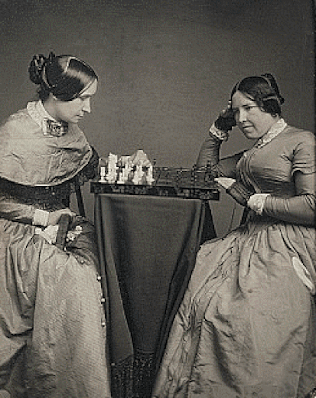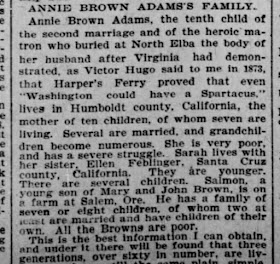"I've often longed to see a war, and now I have my wish. I long to be a man; but as I can't fight, I will content myself with working for those who can."
"John Brown's daughters came to board, and upset my plans of rest and writing....I had my fit of woe up [in the ] garret on the fat rag-bag, and then put my papers away, and fell to work at housekeeping."
(Oh, would we love to see that fat rag-bag in the attic. It's practically a character in the family story.)
About a year after their father's execution Anne Brown and her younger sister Sarah were invited to enroll at Franklin Sanborn's school (tuition perhaps paid by George & Mary Stearns.) They first stayed at Waldo & Lidian Emerson's house with daughter Ellen who told friend Annie Keyes Bartlett that they were "not as homely as she expected them to be.""Frank Stearns' mother is going to give them their outfit [for school.] Poor girls how I pity them, I must try to be kind to them."
Louisa and Bronson "used to spend their evenings in their rooms and Mrs. Alcott played nine men's Morris, alternate games with my sister and myself, than a game of cribbage with my sister, next a game of chess with me, and then Miss Louisa would come down and we all would play Casino...with cards, ending by playing 'Old Maid' chatting pleasantly and going to bed."
The housekeeping that kept Louisa from writing down her ideas apparently did not include much ironing. Annie Brown's observations:
"They were the first persons I ever knew who advocated folding clothes and giving them 'a brush and a promise' instead of spending so much useless time at the ironing board."In a time of starched cottons one might wonder just how presentable Louisa and Abba looked. But Bronson was pampered with starched shirts remembered Annie Brown.
"I used to think that if Mr. Alcott's philosophy had made him wear a few less clean shirts, that his wife might have rested instead of toiling and sweating over the ironing board so long to pamper his fastidious notions."
Crown of Thorns by Addison
After a year in Concord the Brown sisters went home to New York and classes at the Fort Edward Collegiate Institute. Annie taught school during the war and in 1864 their mother decided to move the family west.
Mary Ann Day married the older John Brown when she was 17 and had given birth to 13 children but by the time the Brown girls were living in Concord Annie and Sarah had only two surviving siblings (plus several half brothers and a sister.)
Mary Ann Brown brought a daughter (possibly Annie) to visit the Alcotts right after Louisa's sister married John Pratt in 1860. Louisa described the Browns to her sister Anna:
"Mrs. Brown..."is a tall, stout woman, plain, but with a strong, good face, and a natural dignity that showed she was something better than a 'lady,' although she did drink out of her saucer and used the plainest speech. The younger woman had such a patient, heart-broken face, it was a whole Harper's Ferry tragedy in a look." She must be describing Annie Brown Adams and doing it perfectly.
The year with the Alcotts may have been one pleasant interlude in a difficult life marred by trauma, death, notoriety and poverty. John Brown took 15-year-old Anne to Virginia with him to keep house while he plotted his failed raid on the Federal Armory in Harper's Ferry. She was often referred to as the raid's "only survivor" although this is not true, but one can imagine the callousness of an obsessive father involving his adolescent daughter in his plot to start a slave rebellion (to say nothing of involving his sons who died there)
4 A squares
& 12 large C triangles.
A—Cut 4 squares 2-1/2”
C—Cut 2 squares 2-7/8”. Cut each into 2 triangles with one diagonal cut.
12” Block (3” Grid)
A—3-1/2”
C—3-7/8”
16” Block (4” Grid)
A—4-1/2”
C—4-7/8”
D - Cut 1 square


8” ‐ 1‐7/8”
During the war Union troops marched to the tune of "John Brown's Body" and the Brown women remained heroines to many Northerners. Their lives were never easy, however. Escaping notoriety and crowds of tourists at their New York home the family moved west in 1864.
Annie and Sarah joined sister Ellen, Brother Salmon, his family and mother Mary in traveling to Iowa and then on to Red Bluff, California, arriving in late 1864. Blacksmith Samuel S. Adams, 14 years older than Annie, began courting her. His family had lived near the Browns in Ohio and Kansas. They married November 25, 1869 and soon moved to Rohnerville south of Eureka up in the redwoods country. At 26 Annie became stepmother to 6-year-old girl Irona and 2-year-old Ward.
"Annie Brown Adams made an unfortunate marriage. Her husband was for many years a victim of drink and never made her a fitting support. She got him to go to the northern part of California, where he would be away from bad associations...She has had very bad luck.... Last July [Her heavily mortgaged] house burned down.... "
https://www.google.com/books/edition/A_WOMAN_S_POWER/lHRODwAAQBAJ?hl=en&gbpv=1&dq=%22a+tall+stout+woman+plain%22&pg=PT104&printsec=frontcover
Bonnie Laughlin-Schultz, The Tie That Bound Us; the Women of John Brown's Family and the Legacy
of Radical Abolitionism (Cornell University Press, 2013)
Sandra Harbert Petrulionis, To Set This World Right: The Antislavery Movement in Thoreau's Concord
https://www.google.com/books/edition/To_Set_this_World_Right/GjgIVV2pn6wC?hl=en&gbpv=1&dq=petrulionis+john+brown&printsec=frontcover




























Very much enjoying this BOM! But what is the square size for this month's (Oct) 16" block piece F? I don't find it anywhere.
ReplyDeleteI am fascinated with this block. I’m off to give it a go. Thank you.
ReplyDeletePiece F is missing the size for 12 and 16 in block. It even says so lol
ReplyDeleteSalut, je rêvais de m'offrir un bon vélo de route pour parcourir les chemins de campagne, mais mes économies n'avançaient pas assez vite. Un collègue de travail m'a parlé de https://spinmamas.com/fr en mentionnant leurs bonus adaptés aux joueurs français. Mes débuts ont été compliqués, une série de petites pertes m'a vraiment découragé. J'ai finalement décidé de tenter ma chance avec une mise un peu plus élevée sur un jeu avec un thème cycliste et j'ai décroché un gain inespéré. Cela m'a permis de commander le vélo parfait pour les paysages français. Si vous cherchez une opportunité en France, cet endroit mérite un coup d'œil.
ReplyDelete